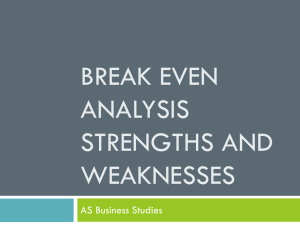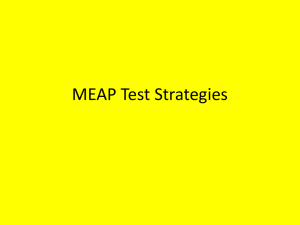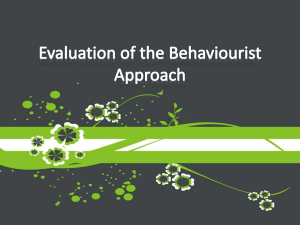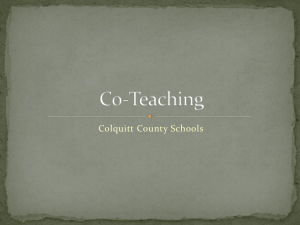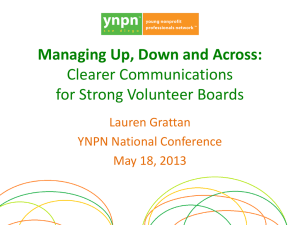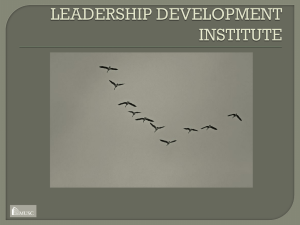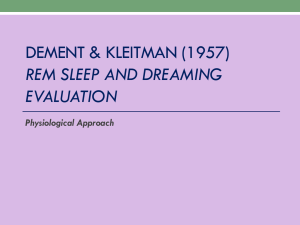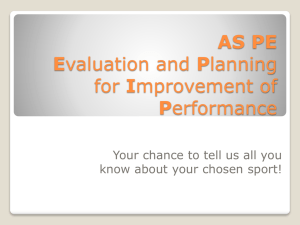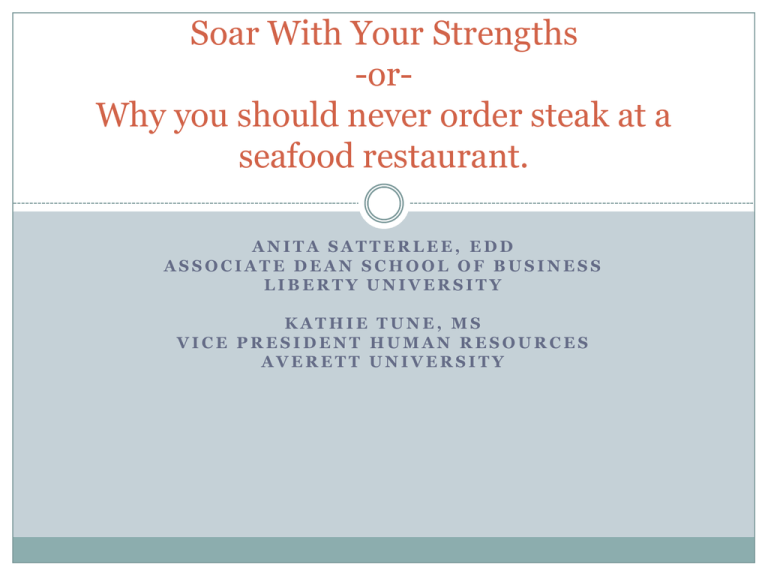
Soar With Your Strengths
-orWhy you should never order steak at a
seafood restaurant.
ANITA SATTERLEE, EDD
ASSOCIATE DEAN SCHOOL OF BUSINESS
LIBERTY UNIVERSITY
KATHIE TUNE, MS
VICE PRESIDENT HUMAN RESOURCES
AVERETT UNIVERSITY
Why
The rabbit goes
to school…
Clifton and Nelson (199). Soar with your strengths. New York: Dell Publishing.
Myths of Strengths & Weaknesses
Fixing weaknesses will make everything all right.
Let the strengths take care of themselves.
Success is the opposite of failure.
Everyone can do anything they put their minds to.
Strength Theory
Find out:
what you do well and --- do more of it
what you don't do well ---and stop doing it.
Strength Theory (cont.)
Strength theory suggests that by fixing weaknesses, you
will become an average performer.
Instead, put the same energy on practicing your strengths, then you
can be a star performer.
Excellence is achieved by focusing on strengths and
managing weaknesses, not through the elimination of
weaknesses.
Develop your strengths to the maximum – they will
become so great that they will overwhelm your
weaknesses.
What Are Your Strengths?
Yearnings
Satisfactions
Rapid learning
Flashes of excellence
Flow
Strengths Quiz
Do you feel you always knew how to do it?
When you practice it, do you get better at it?
Do you know you can perform it well?
Do others applaud you when you do it?
Can you get paid well for doing it?
Do you feel pride and pleasure when you do it?
Weakness Quiz
Feeling defensive about performance.
Obsessive attempts to overcome a behavior.
Slow learning.
No growth from repeated behavior. Being good enough just to
"hang in“ there.
Consciously having to think through the steps of a process
versus the activity being unconscious, automatic and flowing.
Experiencing a reduction in confidence from performing the
activity.
Having the "Just want to get through it" feeling. Forcing your
way through.
Experiencing burnout while practicing an activity.
Managing Weaknesses
Own the weakness.
Acknowledge the weakness as part of you.
Manage the weakness. Stop trying to make it be a
strength, and find a way to minimize its impact.
Do it as little as possible.
Find ways to engage others for whom it is a strength.
Develop and use support systems and tools to compensate,
Find an alternative approach that employs a strength
What Now?
Strengths atrophy and die when left alone.
Strengths develop best within the framework of a
mission. Mission is at the heart of why you do what
you do.
Mission, like exercise, is most effective when
experienced as much as possible.
Mission gives purpose to life. Lacking a mission,
people are likely to have only materialistic goals.
Personal Mission Statements
Attitudes
Values
Beliefs
Objectives
Priorities
Celebrate Strengths
Celebrate what is important in an organization. Find
ways to measure it, and make sure the celebration is
of real achievement. Acknowledge and attend to
achievement in many ways, but be scrupulous about
focusing on REAL achievement, not pretend or
politically motivated back-patting.
Integrate With Our Work
Jim Collins, ‘Good to Great’
Transform from mediocre to great.
Start with who and then determine where.
Good-to-great companies paid little attention to
managing change or motivating people. Under the
right conditions, these problems naturally go away.
Start with ‘who’
Get the right people on the bus
Get the right people in the right seats
Level 5 Leadership
Level 1: Highly capable
Level 2: Contributing Team Member
Level 3: Competent Manager
Level 4: Effective Leader
Level 5: ‘Who’ then ‘What’
Hedgehog Concept
Intersection of 3 concepts
What you can be best in the world at, realistically,
and what you cannot be best in the world at?
What drives your economic engine?
What you are deeply passionate about?
Managing Change
Rational Mind
Emotional Mind
United they effect transformative change
How to Redirect Weaknesses
Find and follow the Bright Spots
Script the Critical Moves
Point to the Destination
References:
Good To Great, Jim Collins, HarperBusiness; 1
edition (October 16, 2001).
Orange Revolution, Adrian Gostick, and Chester
Elton, Free Press (Simon and Schuster); 1 edition
(2010).
Switch, Chip Heath & Dan Heath, Broadway Books, 1
edition (2010).
Andrew J. DuBrin, Applying Psychology, Pearson
Prentice Hall, (6th edition, 2004)
Conclusion
Thanks!


